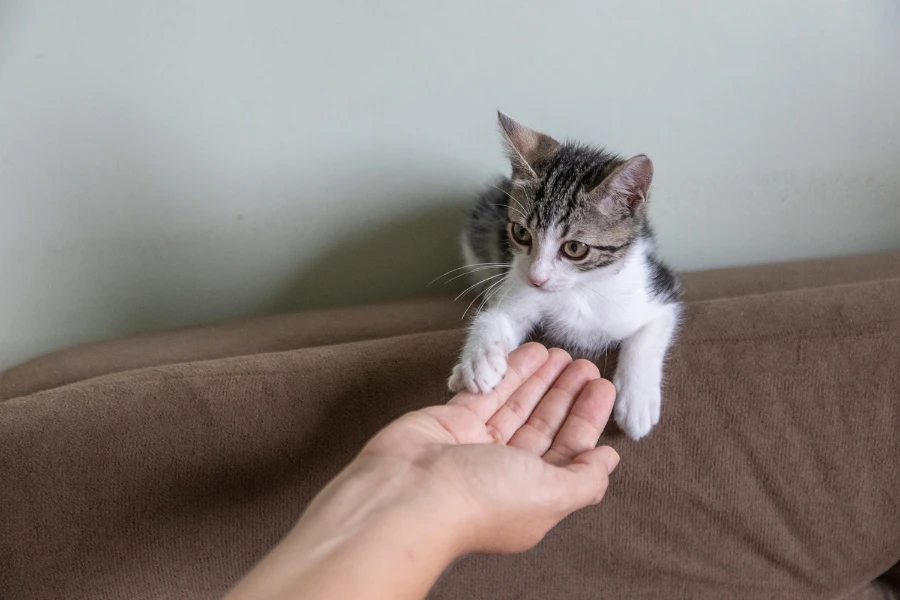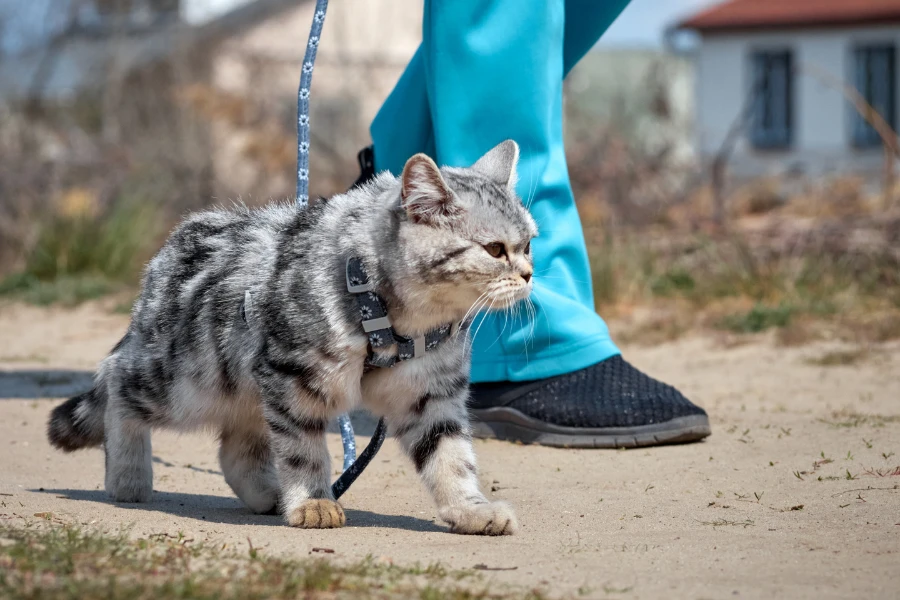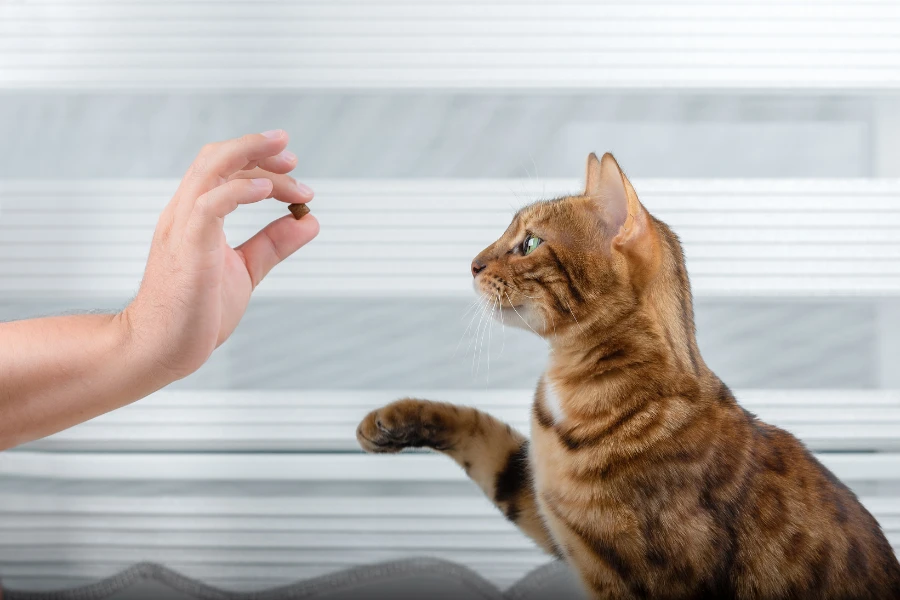Are you thinking of teaching your kitty a few fun tricks? Cat training can be an enjoyable bonding experience that helps keep both you and your beloved feline friend active.
Teaching cats tricks may bring out the best in felines, reducing stress levels and helping create a mutually beneficial relationship between pet parents and their loyal companions.
From sit to paw shake, there are some impressive – not to mention adorable — tricks that can help improve behavior while sharing special moments with our furry friends.
Key Takeaways
- Teaching your cat tricks can improve their overall well-being and create a stronger bond between you and them.
- Clicking or treating training methods using positive reinforcement leads cats to different tasks.
- Tricks such as saying “sit,” shaking hands, giving high fives, and playing fetch keep cats mentally stimulated, preventing boredom which leads to destructive behaviors.
- Training basics such as coming when called, sitting on command, and even walking on a leash help keep outdoor cats safe.
Fun Tricks To Teach Your Cat
Teaching Your Cat To Sit
Training your cat to sit is an easy and fun way to start teaching them tricks, with plenty of rewards for you and your feline friend. This simple trick can be taught by getting their attention with a treat or toy, gently lifting their front paws off the ground as they follow the reward, and then answering with verbal commands or clicking from a clicker when in position.
Rewarding them consistently after each successful attempt allows your cat to quickly learn this new behavior while strengthening the bond between you two.
Teaching your cat to sit is beneficial because it’s cute and establishes good habits that can be used in other, more advanced training methods. Positive reinforcement like treats lets your cat know when they have done something right instead of punishing bad behavior, which may lead to distrust.
Developing an understanding between cues and commands helps create trust. It teaches complex behaviors like coming when called, turning around a certain object on command, waiting until permitted to jump up somewhere, etc.

Teaching Your Cat To Give A Paw Shake
Paw-shaking, also known as paw target training, is fun for cats and can create a lasting bond between them and their owners. To start the training process, you’ll need a clicker and treats that your cat loves – reward him whenever he does something correctly.
You should then hold the treat in one hand and make sure your cat knows it’s there– entice him with quick movements of the treat to grab his attention. As he raises his paw on command or moves towards the treat, he says ‘yes’ when clicking if using a clicker, giving him the treat from your free hand.
With consistent practice over multiple short sessions adding verbal cues such as ‘paw’ while raising your hand at the same time and pairing these actions with certain words like ‘give paw’ will eventually become an ingrained habit for your feline friend.
When training gets difficult, don’t give up too easily! Visualize small goals you would like to achieve in each session and break complex tricks down into simple, manageable steps before attempting more advanced ones; this could include strengthening commands such as ‘sit’ or ‘come.’
Remember that good rewarding behavior immediately has its benefits–your cat may associate new behaviors quicker if given positive feedback immediately after doing so, which can increase motivation during subsequent training sessions! Don’t forget that just because cats are independent creatures doesn’t mean they can’t learn fun tricks; teaching them how to do so has plenty of mental and physical benefits.

Teaching Your Cat To Give A High Five
Giving your cat the ability to give a high five is a fun way to bond with your feline friend! You’ll need some precision, patience, and treats to teach your cat how to give a high five.
First, offer an open hand for the cat to touch. As soon as they make contact with their paw, make sure you click (if using clicker training) or say “yes” – whichever cue you are using – at that moment and then immediately give them a treat.
Continue doing this until they know the connection between giving their paw and getting rewarded.
Next, when your cat starts touching their paw against your opened hand more consistently and quickly than before, add the verbal command “high five” just before offering them an open palm for them to touch it again so that they can begin associating words with actions.
At this point, take longer breaks in between rewards – if he paws at nothing, specifically layer out of boredom waiting for his reward, don’t reward him; start again by presenting only one time again the cue ‘high-five,’ repetition, increase length of no responses episodes gradually until the desired result is reached.
When maintaining longer streaks without any response from yourself, eventually, they should put two-and-two together through associative learning and learn what “high-five” means – even without seeing an open palm right away, expect a positive move towards it, indicating recognizing of sound cue given before providing opened palm, target location confirmation.
This would mark the successful completion of the teaching process. Let’s continuously practice completing the reinforcement process. Once done, manage expectations by not aiming too far for advanced tricks but focusing on reinforcing basics instead, helping to establish a strong, reliable foundation for extending limits later on if you want to do so.
You’ll also need lots of patience during these training sessions since every cat learns differently – progress may be slower or faster depending on each pet’s personality! Furthermore, rewarding cats generously is key to ensuring enjoyable experiences overall, which support success rates considerably, maximizing outcomes and gaining the best results ensuring durability achieved successes over the long run.
In addition, several benefits are associated with teaching cats tricks, like giving a high five.

Teaching Your Cat To Play Fetch
Increasingly popular today, teaching your cat to play fetch is a great way to bond with your furry friend. Many cats find fetching and chasing fun, providing them with much-needed mental and physical stimulation while helping them maintain their agility.
To teach your cat how to play fetch, it’s essential to use positive reinforcement, as this will ensure that your feline can learn the trick in a positive environment. Break the trick down into small steps by starting slow – try rolling the toy across a short distance away from you.
When your cat goes for the ball or toy and picks it up in its mouth or claws, give it lots of praise or reward them with treats! Gradually increase the distance between you two so that soon enough, you can casually share an enjoyable game of fetch.
Teaching Your Cat To Walk On A Leash
Leash-training your cat is an enjoyable activity that can benefit you and your feline friend. Even though cats are largely independent animals, leash training allows them to explore their environment safely while providing mental and physical stimulation and allowing better bonding between owner and pet.
To begin leash training, choose the right harness for your cat. Make sure it fits comfortably on them but not too loose so they have some freedom of movement; a snug fit is good enough.
Once you’ve chosen the best size, introduce it to your cat by letting them sniff it and feel more comfortable around it before putting it on for short periods throughout the day.
The next step involves luring/baiting your pet with treats toward where they should walk when going out together or reaching intersections or other obstacles.

Teaching Your Cat To Use The Toilet
Toilet training your cat can be an exciting and rewarding experience for you and your feline friend. You will need to purchase a special litter box or toilet system to use with the process and some easy-to-clean floor mats or rugs in case of any accidents.
Place the litter box on the toilet seat so your cat learns where it should go. Then introduce them to their litter by placing them inside it multiple times until they understand where their waste needs to go.
Reward them with treats every time they step into their new loo! Once they get the hang of it, gradually lower the pan over a few weeks until it sits flush on the toilet seat.
If your cat is beginning to master this complex trick, then make sure that you give even more positive reinforcement when they stay put long enough to do their business! It can take up to 2 months before the kitty gets used to pottying as humans do – such patience will most certainly pay off in the end! Not only does providing cats with exclusively clean toilets help reduce odor and bacteria build-up around the home, but it also improves overall behavior on cats’ part since there’s no need for burying here either; a pet-friendly reward if we say so ourselves! And just remember while training: keep everything consistent each day and always be patient – we all know our four-legged friends never cease from being active adolescents anyway, so don’t expect too much perfection during such an active learning stage.

Benefits Of Teaching Your Cat Tricks
Not only is teaching your cat tricks fun, but it also has numerous benefits for you and your feline friend.
Improved Bonding
Teaching your cat tricks is a great way to keep them physically and mentally active and an excellent opportunity to solidify the bond between you. When spending quality time with your feline friend — playing together and teaching them some fun tricks — trust deepens as cats learn that their owners are reliable, loving sources of entertainment.
These activities will provide enjoyment and stimulation for you and your pet, creating stronger ties and more understanding among one another.
Tricks like sitting on command, shaking hands, or giving high-fives help build the relationship by creating an understanding between owner and cat while offering mental stimulation in a positive setting.
Another great trick to try out is getting kitty to follow touch cues such as tapping two fingers each time they get close enough – this teaches awareness around hand signals that can be expanded upon when training cats to use litter boxes or other areas associated with proper behavior indoors (or even outside).
No matter what trick you decide to teach first, patience must be key: every cat is different, so don’t rush through training sessions too quickly—be sure to cater each exercise towards the individual learning styles of felines.

Mental And Physical Stimulation
Teaching your cat tricks is a great way to provide mental and physical stimulation that can benefit their overall well-being and provide an enjoyable bonding experience between you and your feline friend.
Teaching the basic “Sit” command alongside more complex commands, such as playing fetch, can keep cats interested in learning new things, preventing boredom which leads to destructive behaviors like aggression or anxiety.
Clicker training is an effective way to teach cats different kinds of tasks – with this method. Owners use a small device that makes a clicking sound each time they reward their cat with treats or petting as positive reinforcement for good behavior.
From teaching them simple tricks such as giving paw shakes, high-fives, and coming when called to teaching them how to walk on a leash – these activities all require concentration from the furry student.
Improved Behavior
Training your cat correctly is key to obtaining positive outcomes – a fun time spent with your feline friend and improved behavior. Trick training can also help cats learn and use new behaviors in other situations.
Clicker training requires positive reinforcement; rewards encourage good behavior rather than punishment for bad, which can often worsen existing problems or create new ones.
When your cat responds correctly, you should reward them immediately so they understand what you want from them; this reinforces their understanding and encourages more desirable behaviors in future sessions or passing experiences.
Training your cat tricks can even reduce destructive behavior, aggression, and anxiety – all of which would otherwise set back progress when trying to teach them something new.
Tips For Teaching Your Cat Tricks
For best results when training your cat, use positive reinforcement such as verbal praise or a treat for any successes and start with easy tricks.
Use Positive Reinforcement
Positive reinforcement teaches cats tricks such as sitting, high-five, going to the mat, lying down, and more. It rewards a cat’s behavior when they do something correct or desirable with treats or praise.
For example, if your cat performs the desired action—such as sitting on command—you give them a treat as a reward while saying something like “Good kitty!” in a cheerful voice.
Treats that can be used as rewards during positive reinforcement training include portions of their regular food or another favorite treat, such as bits of canned tuna for fish lovers and dried chicken for those who prefer poultry flavor.
For successful results, it’s important to keep sessions short and use consistent cues each time you train them; this will help your cat understand what you are asking them to do.
Patience is also key: always wait for the cats to respond before giving higher level commands (“Give me five!”) or giving additional rewards – if they tried but didn’t succeed at first, don’t punish them – try again later after providing easier tasks (like “sit down!’) and allowing some time passed until they complete it successfully.
Be Patient And Consistent
It is imperative to be patient and consistent when training your cat. Unlike dogs, cats develop slower; they need extra time to process and understand commands, tricks, and cues.
Therefore, consistency is key when teaching them – cats respond slower than dogs do due to the difference in their learning styles. As such, even if your pet seems disinterested or unresponsive for some time during a trick training session, stay focused on the task at hand with patience – it will pay off in the end! It would help if you remembered that cats have shorter attention spans than humans; therefore, keeping training sessions short (but fun!) is advised so your feline friend can digest what you are trying for them without getting overwhelmed or tired.
Break The Trick Down Into Small Steps
Teaching your cat a new trick can be both rewarding and challenging. To make the learning process easier and less overwhelming for your cat, it’s best to break the trick down into small and manageable steps or pieces.
For example, when teaching your cat to give you a high five with their paw, don’t expect them to do this right away – instead, start by simply lifting their paw off the ground as they sit in front of you (and immediately reward them!).
Another useful tip for breaking tricks down into smaller steps is using positive reinforcement via clicker training. Clicker training involves having an object that makes a clicking noise every time your cat completes one step – this action rewards them so they understand what behavior was praised.

Keep Sessions Short And Fun
When teaching tricks to your cat, it’s important to keep training sessions short and fun. This will help keep your feline friend engaged and interested in learning the trick and minimize frustration.
That way, you can ensure that each session ends with a positive reinforcement. An effective way of doing this is by breaking down tasks into smaller steps or stages and rewarding them with treats after each successful step.
It also helps to use gestures or signals when teaching cats rather than relying solely on verbal instructions.
Use Treats As A Reward
Treats are an essential part of training cats, as they can be used to reward good behavior and encourage cats to learn new tricks. Positive reinforcement is one of the best tools for teaching cats; treats are a great way to provide it.
High-value treats such as wet food or fish provide excellent rewards that motivate your cat during trick sessions. It’s important to give the treat immediately after your cat performs a trick so that it’s clear what behavior produced the reward.
Rewarding your cat with a treat will create positive associations between behaviors and being rewarded so that you establish an effective learning process over time.

Conclusion
In conclusion, teaching your cat tricks can be a rewarding experience for both you and your pet! Not only are cats incredibly intelligent creatures with the ability to learn new behaviors and commands, but teaching them fun tricks also provides mental and physical stimulation, which has multiple health benefits.
Furthermore, if done correctly, it can greatly enhance the bond between you and your feline friend. Training basics like come, when called and sit, have many applications in real life—especially if your cat is an outdoor kitty, as they will help keep her safe! In addition, reward-based reinforcement methods such as a clicker or treat training to teach these skills will ensure that each trick is learned happily and quickly.
